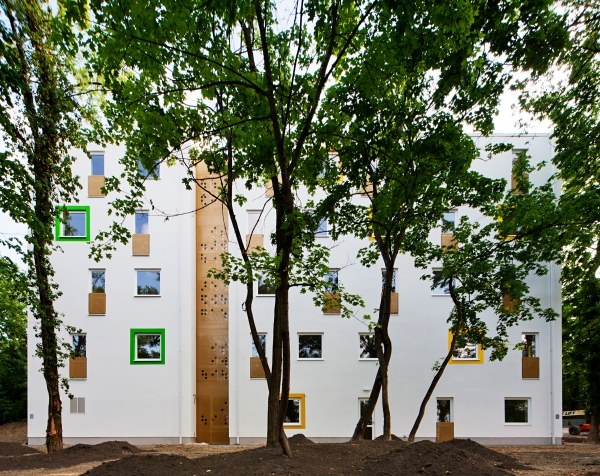Tactile simplicity
The Extension of Blind Children’s Home, Budapest
Architect: Géza Kendik
Text: Anna Zöldi
Photos:Tamás Bujnovszky

Receiving sponsoring from Azerbaijan, the latest project by A4 studio was built in the hills as an extension of a Catholic children’s home. This high-standard building hides on a hillside in Buda, featuring values that are hidden not only from prying eyes by the high-density development – they are also invisible for those who use it. Children living in this home are not only visually impaired – meaning they are blind or have poor eyesight –, their majority is severely and multiply handicapped, injured, disabled. mentally backward, which means that their families are unable to take care of them. The exemplary model-type structuring, as well as the exterior design of the building results directly from the special needs of the home-dwellers to use space individually. The five-storey house repeats the same system of communication level by level: all the rooms open from centrally positioned corridors that cross each other at a right angle. The four spatial segments which are also clearly separated by visual means house various functions, which is reflected in the designs of facades and units. The corner which best communicates with the common garden is actually a community area on each level, the living rooms face the protected side of the building whilst the auxiliary functions are housed in the rooms overlooking the old building. This is the structure repeated on each level as the rhythm of stimuli which are always identifiable and easy to recognize are the keys for spatial orientation for people with poor eyesight. A single spectacle of the facade of the building is the concentration of perforated metal sheet shades which are especially accentuated at the corners functioning as community areas. This is the only visual experience-component which is unnecessary in the composition and as such, it also evidently conveys a symbolic message reaching far beyond the domain of architecture.
Leading architect: Géza Kendik – Stúdió A4 Kft.
Architects: Zoltán Papp, Viktória Dóczy, Orsolya Maza – Stúdió A4 Kft.
Landscape: Márta Preszter – Stúdió A4 Kft.
Statical works: Viktor László – Konstruaterv Kft.
HVAC: Benedek Végh – Astra-Consilium Kft.
Electrical engineering: Károly Pipó – Insta-Elektro Kft.
Main contractor: Grabarics Építőipari Kft










